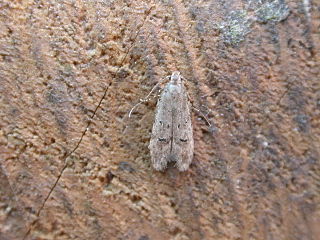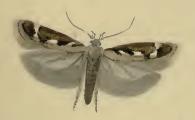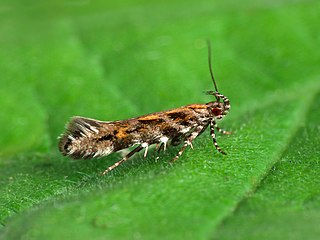
Athrips mouffetella is a moth of the family Gelechiidae. It is found from central and northern Europe to the Ural Mountains, Siberia and the Russian Far East. It has also been recorded from North America.

Recurvaria leucatella is a moth of the family Gelechiidae. It is found in most of Europe, Turkey, Central Asia and the Caucasus.

Carpatolechia proximella is a moth of the family Gelechiidae. It is found in most of Europe, Turkey, the Caucasus, Central Asia and Siberia.

Monochroa lucidella is a moth of the family Gelechiidae. It is found in most of Europe, except Spain, Switzerland and most of the Balkan Peninsula. It is recorded from the Near East and Siberia (Transbaikalia).

Teleiodes vulgella is a moth of the family Gelechiidae. It is known from most of Europe, east to the southern Ural and the Volga region.

Agonopterix conterminella is a moth of the family Depressariidae which is found in Asia, Europe and North America. It was described by Philipp Christoph Zeller in 1839 from a specimen found in Augsburg, Germany. The larvae feed on the terminal shoots of willows.

Caryocolum fraternella is a moth of the family Gelechiidae. It is found in Ireland, Great Britain, Fennoscandia, Denmark, Germany, the Netherlands, France, Switzerland, Spain, Latvia, Estonia and Ukraine.

Caryocolum marmorea is a moth of the family Gelechiidae. It is found from Scandinavia to the Mediterranean islands, and from Ireland to Poland, Hungary and Greece. It is also found on the Canary Islands and Madeira. It is also found in North America.

Carpatolechia decorella is a moth of the family Gelechiidae. It is found in most of Europe, as well as in Turkey, the Caucasus, Kazakhstan, North Africa and on the Canary Islands.

Aristotelia ericinella is a moth of the family Gelechiidae. It is found in most of Europe, except most of the Balkan Peninsula.

Bryotropha affinis is a moth of the family Gelechiidae. It is found in most of Europe.

Anacampsis temerella is a moth of the family Gelechiidae, found in most of Europe, except Belgium, Switzerland, the Iberian Peninsula and the Balkan Peninsula.

Athrips tetrapunctella is a moth of the family Gelechiidae. It is found in France, Great Britain, Ireland, Fennoscandia, Denmark, Estonia, Latvia, Russia and Ukraine. In the east, the range extends through the southern Ural and Siberia to Primorsky Krai.

Carpatolechia fugitivella, the elm groundling, is a moth of the family Gelechiidae. It is found in almost all of Europe, Turkey, the Caucasus, Mongolia, southern Siberia, the Russian Far East and Korea. It is also found in Canada, where it has been recorded from Ontario and Quebec. The habitat consists of woodland, parks, gardens and hedgerows.

Chionodes distinctella, the eastern groundling, is a moth of the family Gelechiidae. It is found in almost all of Europe, as well as most of Russia, Kazakhstan, Central Asia and North Africa. The habitat consists of dry, rocky heath and meadows and the verges and rough pastures.

Exoteleia dodecella, the pine bud moth, is a moth of the family Gelechiidae. It is widely distributed from western Europe to Siberia. It is an introduced species in North America.

Teleiodes luculella, the crescent groundling, is a moth of the family Gelechiidae. It is found from Europe to the southern Ural and Transcaucasia. The habitat consists of woodlands, including oak woodlands.

Gelechia rhombella, the apple groundling, is a moth of the family Gelechiidae. It is found in Europe, the Caucasus, Transcaucasia, southern Siberia, the Russian Far East, Korea and China.

Gelechia sororculella, the dark-striped groundling, is a moth of the family Gelechiidae. It is widely distributed from Europe, throughout Siberia to the Russian Far East.

Scrobipalpa samadensis, the buck's-horn groundling, is a moth of the family Gelechiidae. It is found in most of Europe and Russia.


















